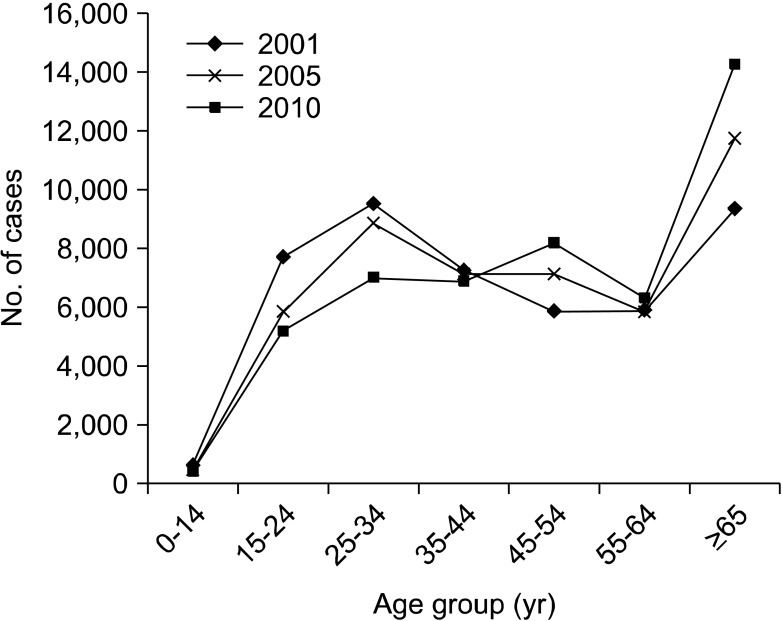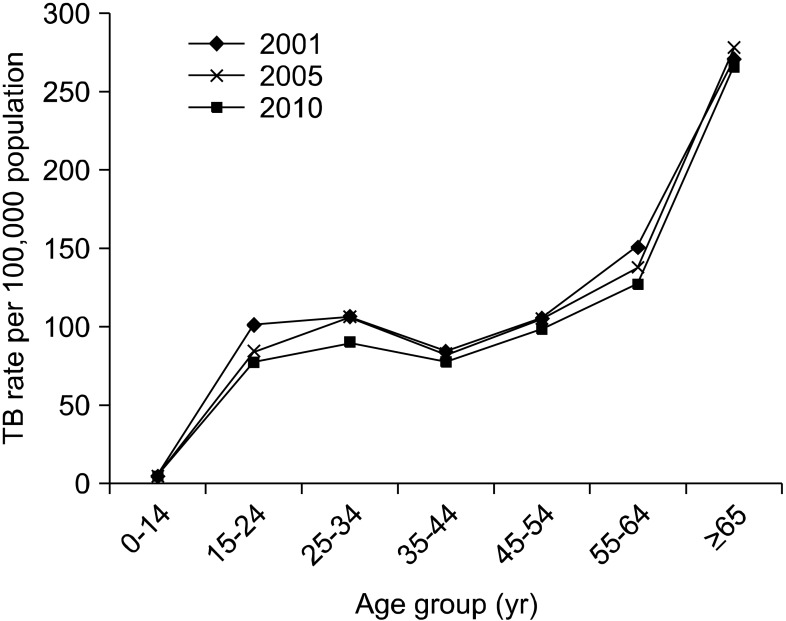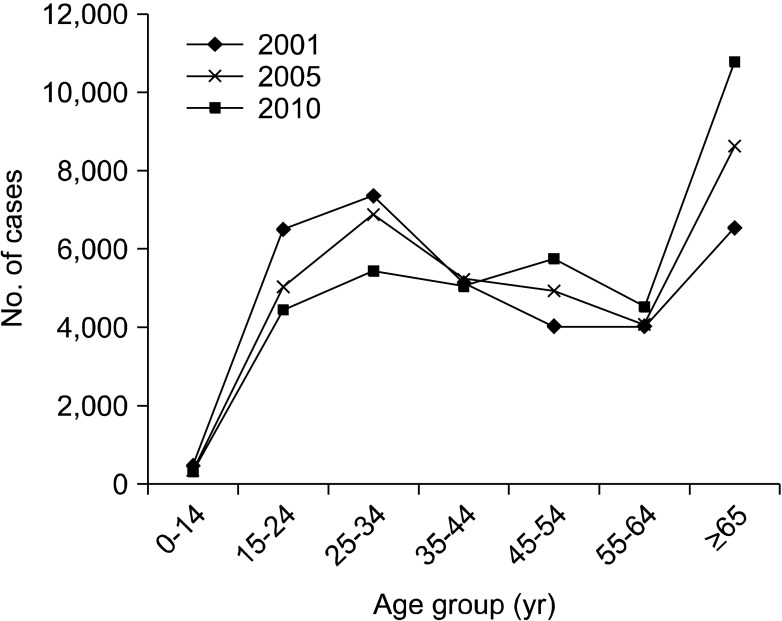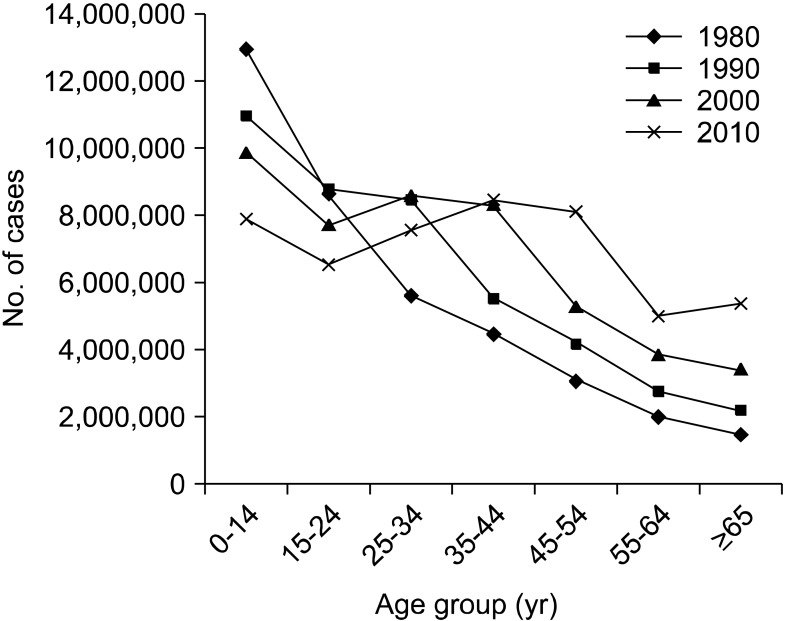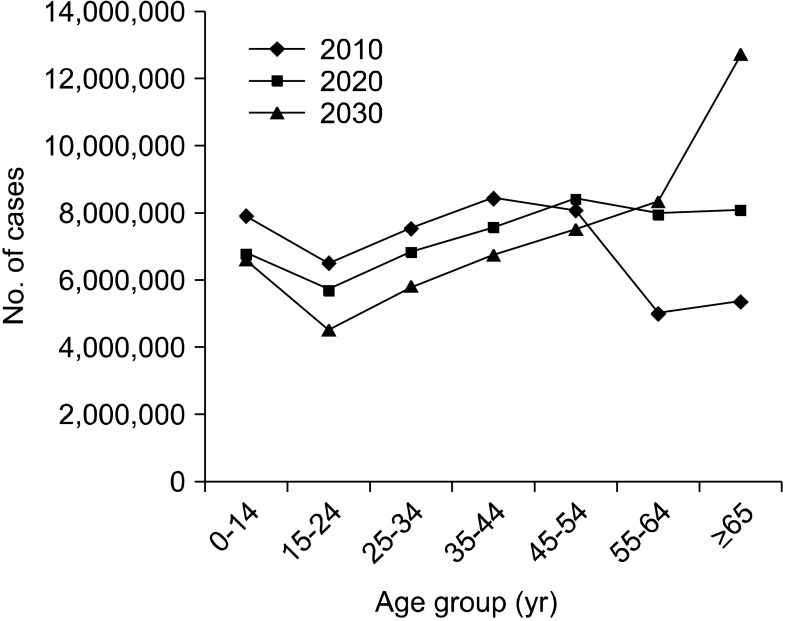Tuberc Respir Dis.
2013 Mar;74(3):104-110.
Increased Tuberculosis Burden Due to Demographic Transition in Korea from 2001 to 2010
- Affiliations
-
- 1Korean Institute of Tuberculosis, Cheongwon, Korea. ypark7@empas.com
- 2Division of HIV and TB Control, Korea Centers for Disease Control and Prevention, Cheongwon, Korea.
Abstract
- BACKGROUND
Notified tuberculosis (TB) cases in Korea have not decreased over the last decade (2001-2010).
METHODS
To clarify the reasons, we analyzed an annual report on notified tuberculosis patients and age-specific population drift in Korea.
RESULTS
Compared to the age-specific notified TB cases between 2001 and 2010, distinctive features in notified TB cases and new cases increased markedly in people aged 45-54 years and in patients over 65 years old, whereas those between 15-34 years in 2010 decreased drastically. In particular, notified TB individuals over 65 years old occupied 29.6% of the cases in 2010, which was 1.5 times higher than that in 2001. The main reason not to decrease in notified TB patients for the last decade (2001-2010) was due to the increasing elderly population as well as the aging of baby boomers, which have a higher risk of TB development.
CONCLUSION
Korea needs to pay attention to the older population in order to successfully decrease the burden of TB in the future.
Keyword
Figure
Reference
-
1. World Health Organization. Global tuberculosis report 2012. WHO/HTM/TB/2012.6. 2012. Geneva: World Health Organization.2. Hong YP, Kim SJ, Lew WJ, Lee EK, Han YC. The seventh nationwide tuberculosis prevalence survey in Korea, 1995. Int J Tuberc Lung Dis. 1998; 2:27–36. PMID: 9562108.3. Korean Center for Disease Control and Prevention. Annual report on the notified tuberculosis patients in Korea, 2001. 2002. Seoul: Korean Center for Disease Control and Prevention.4. Korean Center for Disease Control and Prevention. Annual report on the notified tuberculosis patients in Korea, 2002. 2003. Seoul: Korean Center for Disease Control and Prevention.5. Korean Center for Disease Control and Prevention. Annual report on the notified tuberculosis patients in Korea, 2003. 2004. Seoul: Korean Center for Disease Control and Prevention.6. Korean Center for Disease Control and Prevention. Annual report on the notified tuberculosis patients in Korea, 2004. 2005. Seoul: Korean Center for Disease Control and Prevention.7. Korean Center for Disease Control and Prevention. Annual report on the notified tuberculosis patients in Korea, 2005. 2006. Seoul: Korean Center for Disease Control and Prevention.8. Korean Center for Disease Control and Prevention. Annual report on the notified tuberculosis patients in Korea, 2006. 2007. Seoul: Korean Center for Disease Control and Prevention.9. Korean Center for Disease Control and Prevention. Annual report on the notified tuberculosis patients in Korea, 2007. 2008. Seoul: Korean Center for Disease Control and Prevention.10. Korean Center for Disease Control and Prevention. Annual report on the notified tuberculosis patients in Korea, 2008. 2009. Seoul: Korean Center for Disease Control and Prevention.11. Korean Center for Disease Control and Prevention. Annual report on the notified tuberculosis patients in Korea, 2009. 2010. Cheonwon: Korean Center for Disease Control and Prevention.12. Korean Center for Disease Control and Prevention. Annual report on the notified tuberculosis patients in Korea, 2010. 2011. Cheonwon: Korean Center for Disease Control and Prevention.13. Korean Center for Disease Control and Prevention. Annual report on the notified tuberculosis patients in Korea, 2011. 2012. Cheonwon: Korean Center for Disease Control and Prevention.14. Lew WJ, Lee EG, Bai JY, Kim HJ, Bai GH, Ahn DI, et al. An Internet-based surveillance system for tuberculosis in Korea. Int J Tuberc Lung Dis. 2006; 10:1241–1247. PMID: 17131783.15. Park YS, Hong SJ, Boo YK, Hwang ES, Kim HJ, Cho SH, et al. The national status of tuberculosis using nationwide medical records survey of patients with tuberculosis in Korea. Tuberc Respir Dis. 2012; 73:48–55.
Article16. Hong SJ, Park YS, An H, Kang SM, Cho EH, Shin SS. Factors leading to under-reporting of tuberculosis in the private sector in Korea. Int J Tuberc Lung Dis. 2012; 16:1221–1227. PMID: 22794136.
Article17. Yoo JW, Jo KW, Kim MN, Lee SD, Kim WS, Kim DS, et al. Increasing trend of isolation of non-tuberculous mycobacteria in a tertiary university hospital in South Korea. Tuberc Respir Dis. 2012; 72:409–415.
Article18. Lee SK, Lee EJ, Kim SK, Chang J, Jeong SH, Kang YA. Changing epidemiology of nontuberculous mycobacterial lung disease in South Korea. Scand J Infect Dis. 2012; 44:733–738. PMID: 22720876.
Article19. Statistics Korea [Internet]. cited 2012 Oct 30. Daejeon: Statistics Korea;Available from: http://kostat.go.kr/.20. Mori T, Leung CC. Tuberculosis in the global aging population. Infect Dis Clin North Am. 2010; 24:751–768. PMID: 20674802.
Article21. Dye C, Williams BG. The population dynamics and control of tuberculosis. Science. 2010; 328:856–861. PMID: 20466923.
Article22. Vynnycky E, Borgdorff MW, Leung CC, Tam CM, Fine PE. Limited impact of tuberculosis control in Hong Kong: attributable to high risks of reactivation disease. Epidemiol Infect. 2008; 136:943–952. PMID: 17678555.
Article23. Vesosky B, Turner J. The influence of age on immunity to infection with Mycobacterium tuberculosis. Immunol Rev. 2005; 205:229–243. PMID: 15882357.24. Rajagopalan S. Tuberculosis and aging: a global health problem. Clin Infect Dis. 2001; 33:1034–1039. PMID: 11528577.
Article25. Rajagopalan S, Yoshikawa TT. Tuberculosis in the elderly. Z Gerontol Geriatr. 2000; 33:374–380. PMID: 11130191.
Article26. Lee JH, Han DH, Song JW, Chung HS. Diagnostic and therapeutic problems of pulmonary tuberculosis in elderly patients. J Korean Med Sci. 2005; 20:784–789. PMID: 16224152.
Article27. Thrupp L, Bradley S, Smith P, Simor A, Gantz N, Crossley K, et al. Tuberculosis prevention and control in long-term-care facilities for older adults. Infect Control Hosp Epidemiol. 2004; 25:1097–1108. PMID: 15636299.
Article28. Hauer B, Brodhun B, Altmann D, Fiebig L, Loddenkemper R, Haas W. Tuberculosis in the elderly in Germany. Eur Respir J. 2011; 38:467–470. PMID: 21804163.
Article29. Yamagishi F. Tuberculosis in the elderly. Kekkaku. 2004; 79:481–486. PMID: 15484832.30. Lo HY, Chou P, Yang SL, Lee CY, Kuo HS. Trends in tuberculosis in Taiwan, 2002-2008. J Formos Med Assoc. 2011; 110:501–510. PMID: 21783019.
Article31. Research Institute of Tuberculosis. JATA. Tuberculosis annual report 2009. Series 4. Elderly TB. Kekkaku. 2011; 86:737–741. PMID: 21922784.
- Full Text Links
- Actions
-
Cited
- CITED
-
- Close
- Share
- Similar articles
-
- Underestimated Burden: Non-Communicable Diseases in North Korea
- Burden of Disease in Korea: Years of Life Lost due to Premature Deaths
- Trend of Multidrug and Extensively Drug Resistant Tuberculosis in a Tuberculosis Referral Hospital, 2001~2005
- Transition Model of Middle-aged Women
- Characteristics of tuberculosis in children and adolescents

